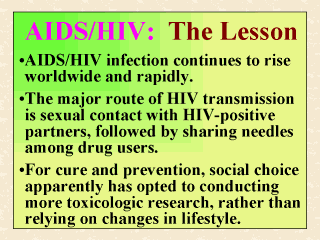| front |1 |2 |3 |4 |5 |6 |7 |8 |9 |10 |11 |12 |13 |14 |15 |16 |17 |18 |19 |20 |21 |review |
 |
Like the first
two case studies, the causative agent for this third case has also been identified.
However, this third case study is unique in that the number of patients reported to have
AIDS or HIV infection worldwide continues to rise rapidly year after year to this day,
even long after the causative agent and the major transmission modes have been identified.
There is still much to learn about the mechanism of toxicity involved, about how HIV
exactly attacks the immune system, and about how to contain the seemingly uncontrollable
mass self reproduction of HIV in the body. Yet despite the lack of such toxicologic
understanding, one thing is quite certain regarding the prevention of AIDS or HIV
infection. Epidemiologic data show that the major route of transmission is sexual contact with HIV-positive partners, followed by sharing needles among injection drug users. And toxicologic information gathered to this day has identified HIV as the eventual causative agent of AIDS. Yet it appears that social choice has opted to alter the course of this pandemic through further toxicologic research over the method of changing one’s (as well as the society’s) lifestyle. A perplexing question thus remains: What if to this day HIV still could not be isolated and identified as the causative agent of AIDS? Would we then be more receptive to changing our sexual behavior or personal lifestyle as a means of coping with this pandemic? Or the understanding of causation must always precede prevention? |